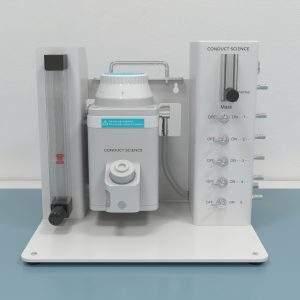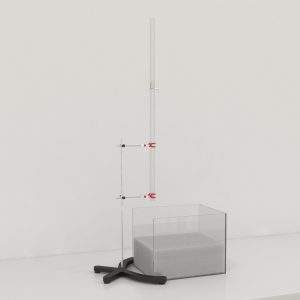$1,890.00 – $1,990.00
The Lashley III maze is a tool designed to assess learning and memory. It provides a low-stress setting to examine route learning through a maze over multiple trials. Standard protocols avoid stress, food deprivation, or other stimuli. The MazeEngineers apparatus includes a start box, maze body, and goal box. To encourage task completion, the goal box can be filled with bedding that resembles a home cage, serving as a reward for mice. Although a large red base is not included with the standard order, it is available upon request.

MazeEngineers offers custom-built behavioral mazes at no extra cost—designed to fit your exact research needs. Eliminate reproducibility issues from poor sizing or lingering scent cues with precision-engineered, modular, and smart mazes that adapt in real time to animal behavior. Publish new protocols, run adaptive experiments, and push the boundaries of behavioral science.



Features |
Arm Length: 45cm x 7cm height x 5cm width |
Doors: 4cm x 4cm; located 11cm from walls |
Goal box: 19.5cm long x 7cm height x 5cm width |
Start box: 8cm x 9.5cm x 7cm |
Clear rooftop |
Base does NOT come with the Lashley by default |
Features |
Arm Length: 60cm x 10cm height x 8cm width |
Doors: 6cm x 6cm; located 14cm from walls |
Goal box: 26cm long x 9cm height x 6cm width |
Start box: 10cm x 12cm x 9cm |
Clear rooftop |
Base does NOT come with the Lashley by default |

The Lashley III alternation task is extensively used to evaluate learning and memory in rodents. This task involves route learning, where subjects navigate a maze through repeated trials. Developed by Karl Lashley in 1929, the apparatus was instrumental in his research to locate memory engrams in the cortex using cortical lesioning techniques. The paradigm is designed to be low-stress, typically conducted during the dark phase and without aversive stimuli, until the subjects reach the goal box from the start box.
The apparatus features an integrated start box, a four-arm maze, and a goal box. In modified versions, a pseudo-home cage is added at the end of the goal box. This pseudo-home cage contains the same bedding as the subject’s original home cage and remains specific to each subject throughout the experiment. This setup provides significant motivation for the subjects to learn the routes in the Lashley III maze (Blizard et al., 2006).
Originally, Karl Lashley used food cues for motivation. However, later modifications replaced food cues with the pseudo-home cage, which offers comparable motivation. Some researchers have also used food pellet rewards to encourage route learning in the Lashley III maze (Matzel et al., 2003).
The Lashley III maze is made from black acrylic with individual Plexiglas lids for each section, creating a low-light environment to simulate the dark phase. The apparatus features non-transparent acrylic walls and transparent lids. It includes a start box, four maze arms with five decision points, eight blind alleys, and a goal box. Additionally, it can be enhanced with a pseudo-home cage. The modular design allows for easy cleaning and customization.
Typically, the maze arms measure approximately 45 cm in length, 7 cm in height, and 5 cm in width. The decision point doors are about 4 x 4 cm and are positioned around 11 cm from the outer walls. The start box dimensions are approximately 8 x 9.5 x 7 cm, while the goal box measures about 19.5 x 7 x 5 cm. The transparent Plexiglas lids provide clear visibility of the subjects as they navigate the maze and prevent escape. The maze is generally set on a red Plexiglas base that can support the apparatus along with the pseudo-home cage, which is roughly the same size as the subject’s standard home cage.
Before the testing procedure, the subjects should be brought to the testing room for acclimation. For food cued motivation, the subjects are water and food deprived for some specific time usually 24-36 hours, but for the pseudo-home cage motivation, the water and food are generally removed half an hour before the testing. The procedure for Lashley III, especially when pseudo-home cage technique is employed for motivation is usually conducted during the dark phase as the subjects are food and water-satiated at this time. The dark phase provides an additional driving force to the subjects to explore the maze.
First, the maze should be thoroughly wiped with 70% ethanol solution. Initially, the doors of the start box leading to the maze arms should be kept closed. Then the subjects should be carefully placed in the start box, and the top lid is firmly secured to restrict the subjects from leaving the apparatus. Then the door leading to the maze arms should be opened, and stopwatch should be started. The pathway followed by the subject should be recorded either manually or through a video tracking software such as Noldus Ethovision XT. The latency to enter every arm, and the number of errors made should be properly documented.
For the manual recording of data, stop the stopwatch when all four paws of the subjects are in the first arm of the Lashley III maze. This time is recorded as the latency to enter the maze. When the subject reaches the goal box with its all four inside it, stop the second stopwatch, and the note down it as the latency to the enter the goal box. The doors that lead back to the maze arm should be immediately closed. Finally, stop the third stopwatch when the subject completely enters the pseudo home cage; record this time as the latency to enter the pseudo home cage.
Every time the subject enters the dead end or travels to the maze arm already traveled is taken as an error. These errors are referred as forward and backward errors respectively. The number of errors made by the subjects should be properly recorded. The manual recording of data is prone to human error; therefore the use of an automated video tracker such as Noldus Ethovision XT limits this problem efficiently.
The subject should be safely removed from the pseudo home cage after 1 minute before returning it to its standard home cage. The same process is repeated for all the subjects in the testing cohort. The subjects should be tested in the same order on consecutive trials. All the subjects are tested on consecutive nights, with only one trail on each day for each subject. The testing procedure is repeated until the learning criterion is met. However, the testing procedure should be ceased after the predetermined test trails are completed, regardless the subjects achieve the learning criterion or not. The learning criterion is met when the subject navigates the maze and reaches the pseudo home cage making 0 or 1 error(s) on two successive trials.
The Lashley III maze is utilized to assess both learning and retention capabilities. Learning ability is demonstrated by reaching a specific learning criterion. To evaluate retention, subjects are tested again after seven days, with their latencies recorded and compared to previous results to determine their retention ability (Espinoza-Cifuentes and Zeise M, 2008).
The Lashley III maze can also be employed to study the impact of aging on rodents’ learning abilities. In 2010, Bressler et al. made slight modifications to the apparatus to assess how age affects the achievement of the learning criterion.
In a study by Pinto-Hamuy et al. (2004), ibotenic acid lesions in blind rats, confined to the anteromedial complex region but not to Oc1, disrupted spatial reference memory in the Lashley III maze. They also found a positive correlation between the lesion’s extent in the anteromedial complex and the severity of the retention deficit.
The modular design of the Lashley III maze allows researchers to test various aspects of learning and retention. After the learning criterion is met, the maze can be rotated, changing the positions of the doors and choice points. This requires the subject to learn a new route to meet the learning criterion for this new configuration.
Additionally, the Lashley III maze can be modified by introducing odor cues or noise stimuli to further motivate maze exploration. To investigate state-dependent learning and memory, aversive stimuli like restraints can also be used.
Fig1: Days to achieve learning criterion in 3 months and 20 month old subjects
The sample data can be visualized by comparing the time spent to achieve learning criterion in subjects with respect to age. It is evident from the graph that with the increasing age, the sensory capabilities are decreased; therefore, the older subjects spend more time to meet the learning criterion. Figure 1.
One of the key advantages of the Lashley III maze lies in its modular design, allowing straightforward rotation to reverse the positions of choice points and doors from the initial acquisition phase.
Furthermore, the maze excels in assessing the impact of aging on learning and memory. While the Morris water maze is often favored for its efficiency in evaluating these domains, the Lashley III maze offers a more precise evaluation of performance changes in aging subjects. This is particularly valuable as other tests frequently yield ambiguous results in aging rodents.
Extended training intervals can have detrimental effects on some subjects, leading to over-training. This over-training often results in abnormal behavior within the maze, characterized by an increased number of errors per trial and prolonged durations to achieve the learning criterion.
Bressler A, Blizard D, Andrews A. (2010). Low-stress route learning using the Lashley III maze in mice. J Vis Exp. 22;(39). pii: 1786. Doi: 10.3791/1786.
Lashley, K. (1929). Brain mechanisms and intelligence: A quantitative study of injuries to the brain. University of Chicago Press, Chicago.
Blizard DA, Weinheimer VK, Klein LC, Petrill SA, Cohen R, McClearn GE. (2006). ‘Return to home cage’ as a reward for maze learning in young and old genetically heterogeneous mice. Comp Med. 56(3):196-201.
Louis D. Matzel, Yu Ray Han, Henya Grossman, Meghana S. Karnik, Dave Patel, Nicholas Scott, Steven M. Specht and Chetan C. Gandhi. (2003). Individual Differences in the Expression of a “General” Learning Ability in Mice. Journal of Neuroscience. 23 (16) 6423-6433.
Espinoza-Cifuentes S, Leander Zeise M. (2008). The anteromedial extrastriate complex is critical for the use of allocentric visual cues and in the retention of the Lashley III maze task in rats. Biol Res. 41(4):405-12. Doi: /S0716-97602008000400006.
Pinto-Hamuy T, Montero VM, Torrealba F. (2004). Neurotoxic lesion of anteromedial/posterior parietal cortex disrupts spatial maze memory in blind rats. Behav Brain Res. 31;153(2):465-70.
| Color | Black, Blue, Clear, Green, Grey, Red, White, Yellow |
|---|---|
| Species | Mouse, Rat |
There are no questions yet. Be the first to ask a question about this product.
Monday – Friday
9 AM – 5 PM EST
DISCLAIMER: ConductScience and affiliate products are NOT designed for human consumption, testing, or clinical utilization. They are designed for pre-clinical utilization only. Customers purchasing apparatus for the purposes of scientific research or veterinary care affirm adherence to applicable regulatory bodies for the country in which their research or care is conducted.